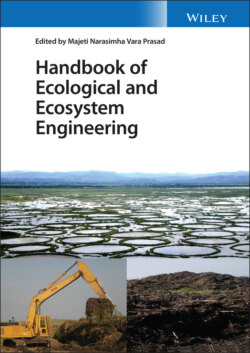Читать книгу Handbook of Ecological and Ecosystem Engineering - Группа авторов - Страница 26
2.2.4 Sloping Areas
ОглавлениеDescription of the marginality factor: Sloping areas change in elevation with respect to planimetric distance [61]. Steep rocky slopes are marginal lands: they are composed of unstable and unbalanced ecosystems that are not favorable to germination, growth, and plant development and are characterized by high soil loss, high evapotranspiration, and low mechanical stability for root development [87]. Such steeper slopes tend to occur in higher areas of the landscape and usually induce more pronounced apparent dryness, often associated with shallow soils, leading to heavy runoff, mechanization difficulties, minimal cultivation opportunities and land management, a greater risk of soil degradation (erosion), and landslides [10].
Revitalization by ecological engineering: Ecological engineering and the use of super‐absorbent polymers can improve the environment through the hydrologic effect of aboveground biomass, improving the adsorption and complexing capacity of hydrophilic functional groups, promoting the formation of a water‐blocking layer between soil particles and thus inhibiting moisture from moving from the soil surface to the atmosphere or to the slope's rock layer, enhancing water uptake and the utilization of water for plant growth, decreasing evapotranspiration, increasing germination rates in grass and woody plant species, and increasing plant survival [87]. This technology can also be used to improve and optimize the use of irrigation water in regions affected by drought, since water and nutrients can be stored and released when needed, enhancing the yields of crops [88].
Revitalization by ecosystem engineering: Shallow soils are often combined with slopes, and plants like Miscanthus spp., giant reed, and switchgrass can easily adapt to such conditions [61, 89]. Bioengineering techniques for slope stabilization and landslide mitigation are already using many plant species that are being investigated for bioenergy purposes. The roots of giant reed and P. purpureum, for example, can act in sloping areas by a variety of mechanical mechanisms: (i) they reinforce the soil, increasing shear resistance, like jute nets, jute reinforcement grids, and geotextiles; (ii) they provide support to slope soils through buttress and arching, since they can anchor deeply in firm strata, similar to shear wrenches and screws or pretensioned rock anchors; (iii) they help compact the soil, increasing the densification and solidification of soil materials, similar to wooden, concrete, or lime piles; and (iv) they unite surface soil particles, increasing cohesive and adhesive forces and reducing susceptibility to erosion and landslides [90, 91].
